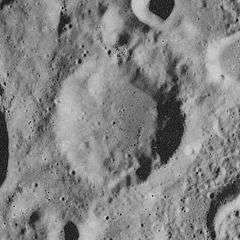Tisserand (crater)
|
Apollo 17 mapping camera image | |
| Coordinates | 21°24′N 48°12′E / 21.4°N 48.2°ECoordinates: 21°24′N 48°12′E / 21.4°N 48.2°E |
|---|---|
| Diameter | 37 km |
| Depth | 2.8 km |
| Colongitude | 312° at sunrise |
| Eponym | François F. Tisserand |

Oblique view also from Apollo 17
Tisserand is a lunar crater that is located just to the east of the larger crater Macrobius, to the northwest of the Mare Crisium.
The rim of Tisserand has been eroded by impacts, with depressions in the southern and northeastern sides, and a nearly tangential curving valley cutting into the inner wall along the northwest. The interior floor is relatively level, with low ridges near the eastern and western inner walls. The eastern half of the floor has a slightly lower albedo than the western half, with the latter part being lightly coated by ray material from Proclus to the south.
Satellite craters
By convention these features are identified on lunar maps by placing the letter on the side of the crater midpoint that is closest to Tisserand.
| Tisserand | Latitude | Longitude | Diameter |
|---|---|---|---|
| A | 20.4° N | 49.4° E | 24 km |
| B | 20.7° N | 51.3° E | 8 km |
| D | 21.7° N | 49.4° E | 7 km |
| K | 19.8° N | 50.4° E | 11 km |
References
- Andersson, L. E.; Whitaker, E. A. (1982). NASA Catalogue of Lunar Nomenclature. NASA RP-1097.
- Blue, Jennifer (July 25, 2007). "Gazetteer of Planetary Nomenclature". USGS. Retrieved 2007-08-05.
- Bussey, B.; Spudis, P. (2004). The Clementine Atlas of the Moon. New York: Cambridge University Press. ISBN 978-0-521-81528-4.
- Cocks, Elijah E.; Cocks, Josiah C. (1995). Who's Who on the Moon: A Biographical Dictionary of Lunar Nomenclature. Tudor Publishers. ISBN 978-0-936389-27-1.
- McDowell, Jonathan (July 15, 2007). "Lunar Nomenclature". Jonathan's Space Report. Retrieved 2007-10-24.
- Menzel, D. H.; Minnaert, M.; Levin, B.; Dollfus, A.; Bell, B. (1971). "Report on Lunar Nomenclature by the Working Group of Commission 17 of the IAU". Space Science Reviews. 12 (2): 136–186. Bibcode:1971SSRv...12..136M. doi:10.1007/BF00171763.
- Moore, Patrick (2001). On the Moon. Sterling Publishing Co. ISBN 978-0-304-35469-6.
- Price, Fred W. (1988). The Moon Observer's Handbook. Cambridge University Press. ISBN 978-0-521-33500-3.
- Rükl, Antonín (1990). Atlas of the Moon. Kalmbach Books. ISBN 978-0-913135-17-4.
- Webb, Rev. T. W. (1962). Celestial Objects for Common Telescopes (6th revised ed.). Dover. ISBN 978-0-486-20917-3.
- Whitaker, Ewen A. (1999). Mapping and Naming the Moon. Cambridge University Press. ISBN 978-0-521-62248-6.
- Wlasuk, Peter T. (2000). Observing the Moon. Springer. ISBN 978-1-85233-193-1.
External links
This article is issued from Wikipedia - version of the 6/29/2016. The text is available under the Creative Commons Attribution/Share Alike but additional terms may apply for the media files.
